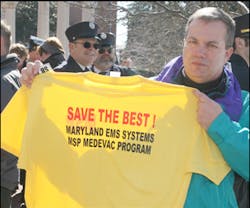Maryland Crews Respond to Save Medevac, Fire Programs
ANNAPOLIS -- Fire, rescue and EMS personnel from across Maryland responded to the state capital Wednesday for a life-saving measure.
They came to keep the state's world renowned EMS and Medevac system alive as well as save the fire and rescue training agency.
Two controversial bills before the Maryland General Assembly -- one to create a new cabinet level agency to handle all Emergency Services and another to revamp the state's helicopter fleet -- have sent shockwaves from the shore to the mountains.
The mother of the flight medic killed in the Medevac helicopter crash last year spoke of her support for the program she called "the best in the world."
Wilma Lippy said her son Mickey, died doing what he loved -- being a flight medic with the Maryland State Police. She said her family's support of the system has not waned.
She joined nearly 200 fire and rescue personnel, state troopers, nurses, physicians and others for a rally in front of the Maryland State House. Fire trucks, squads, ambulances and other fire department vehicles lined the streets nearby.
Lippy urged lawmakers to spend the money to make the program safer, and to keep the MSP Aviation Command intact.
In January, Gov. Martin O'Malley set aside $40M in the 2010 budget to purchase two helicopters.
Although hearings for the two bills were moved until next Wednesday, supporters who are adamant about preserving the programs say they'll be back. The meetings had been scheduled for this afternoon.
Sen. E.J. Pipkin, co-sponsor of the bills, said his goals include making the Medevac program safer, to make sure funds go where they save lives and to raise awareness, focus and performance of all emergency services.
He believes bringing the agencies under one secretary will streamline and reform them.
His bill would allow state police as well as private firms to submit a proposal provide Medevacs.
Sen. John Astle, the bills' co-sponsor, is a former pilot with Medstar based at Washington Hospital Center. He has tried repeatedly over the years to get the state to open the door for other firms to fly missions.
Despite the September crash that claimed four lives, a national panel of HEMS experts said it considers Maryland's program exemplary and a model for the nation.
Maryland motorists help fund the program through fees on vehicle registration. No one flown to a trauma or specialty care center receives a bill.
Privately owned helicopter firms have long courted state legislators asking for a piece of the action. Citizens transported by these choppers have received bills, some for as much as $10,000 according to state officials.
H.B. Martz, representing Maryland Flight Paramedics, said his group supports the system as it stands today. "We shouldn't have to be here," he said, adding that the exemplary program speaks for itself.
Dr. Robert Bass, executive director of Maryland Institute for Emergency Medical Services Systems (MIEMSS) said the system has proven itself time and time again. He added that improvements are needed, and believes the fleet needs to be replaced.
Bass, who did not speak at the rally, also called the multi-faceted system cost effective as well. He will testify next week about how important it is to keep MIEMSS as it is. Maryland's trauma system has been recognized as one of the country's best.
The chief trauma surgeon at MIEMSS, Dr. Tom Scalea, said Maryland's system is known as a model around the world. He said he's been told: "We wish we have what you have..."
He said the pending legislation destroys the principles of the EMS system -- "The right person, the right place, the right amount of time."
Scalea said residents should know that privately owned companies traditionally place helicopters where there are the most people. He said everyone deserves the same service despite where they live.
For the past 40 years, the EMS program has been supported for the people in Maryland by the people in Maryland, he said, adding that it makes no sense to change it.
Simeon Klebaner, a paramedic who flies with the Park Police, said Maryland should be proud of its Medevac program.
A former supervisor with EMS in New York City, he said for-profit helicopter programs often don't think about the patient first.
That's not the case, however, in Maryland. Here, patients come first, he said.
Under an MOU, Park Police handle missions when the state police helicopters are busy. Another bill would create an executive branch Department of Emergency Services, and eliminate the Maryland Institute for Emergency Medical Services Systems (MIEMSS) and the state EMS Board.
Other agencies that would come under this cabinet position would include Maryland Fire Rescue Institute (MFRI), shock trauma and Maryland Emergency Management Agency (MEMA).
MFRI director Steve Edwards said it's imperative that his agency keep its ties with the University of Maryland as it has since the 1930s. "There is no fire service group or state agency that supports these bills." In the past four years, MFRI has conducted a number of firefighter safety studies funded by more than $3.2M in FIRE Act grants.
Funds so vital for research projects may not be available if the agency comes under a new umbrella, he said.
Keeping MFRI in the UM system also assures college credits for those who take their classes. Last year, 36,745 fire, rescue and EMS personnel were trained in the myriad of programs offered.
Edwards and Bass as well as officials from other agencies targeted by the legislation stood silently Wednesday as others took the podium. Next week, they say they will address law makers about their concerns, and how it will impact the Maryland system.
